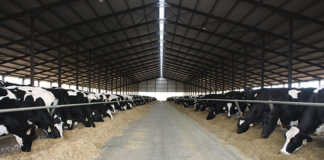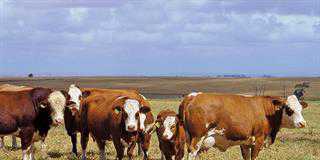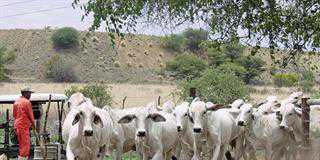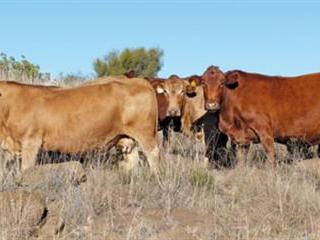
“Our aim is to run efficient beef cattle that produce with the least effort at the lowest cost,” says Alwyn Marx, of Essex Farm, about his decision to introduce Tuli cattle to a livestock operation dominated at the time by Dohne Merinos. This region is considered to be an ecotone (transition area) and veld types on the farm range from mixed grassland to Karoo veld. The climate is one of extremes with hot summers and cold winters, and an average annual rainfall of 450mm.
Alwyn needed to choose a hardy, disease-resistant breed that matured early and conceived and calved easily. “We don’t want to put out too much lick, we don’t want to inject or dip too often, but we do want decent marketable calves at 7 months,’’ he says.
The indigenous African-bred Tuli seems to have brought all the right traits to the party. The ability of the 450kg to 500kg cows to consistently produce quality, market-ready weaners under extensive conditions has radically altered the Marx beef operation. “Nothing can beat a cow that produces this much marketable beef per hectare of veld,” Alwyn says.
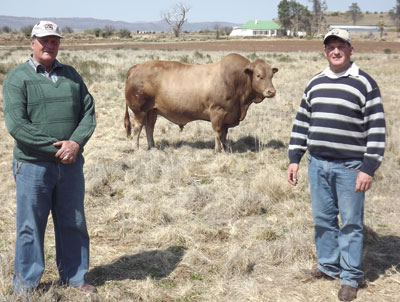
Harm and Alwyn Marx with an Alpha and Omega Tuli herd sire (R 07 41) on Essex Farm near Burgersdorp in the Eastern Cape.
Choosing the Tuli
They decided on Tuli cattle after researching the productive capabilities of various breeds under extensive conditions, says Alwyn. The breed was suggested by family friend and consultant Stefan van Wyk, who in 2002 bought 20 registered Tuli cows and the bull HWP 99 250 on their behalf at the dispersal sale of the late Wallace Potgieter of Villiers in the Free State.
The cattle were transported to Burgersdorp and for the next two years their production was compared to that of two well-known breeds the Marx family had run for years in the often extreme Stormberg conditions. The Tulis outperformed their competitors on fertility and in terms of their ability to wean better calves relative to maternal body weight. They were supplemented only with rock salt year-round and NUTRI Tub maintenance lick in winter.
“In the first year the cows all calved and held their condition. The following year they had a 100% conception rate and weaned calves at an average 54% of their own weight,” recalls Alwyn. “I realised that these cattle were something special.” Once committed to the breed, Alwyn began to buy more Tulis at auctions. He realised that the most efficient way to obtain the best genetics was to buy old cows directly from stud breeders and flush embryos from them. In this way he introduced the best genetics he could find into the Tuli herd, registering it as the Alpha and Omega Tuli Stud in 2004.
He sources additional females from top breeders such as Koot and Jan van der Walt of Rits Tulis (Venterstad, Eastern Cape), Russell Clark of HBH Tulis (Dordrecht, Eastern Cape), Cornelius and Albie Rautenbach of Nonnie & Langlyf studs (Reitz, Free State) and Dave Mullins of the Avondale stud (Grahamstown, Eastern Cape).
Fertility and longevity
The Tuli’s almost uncanny fertility, a trait regarded as having low heritability, is combined with good milk production. Alwyn says that Alpha and Omega Tuli cows have never had a conception rate lower than 94%, an impressive figure in a stud herd that has grown from 20 cows in 2002 to 300 breeding females in 2012. Alpha and Omega Tuli females are run in single sire breeding herds that calve from September to December. No more than two new bulls a year are introduced.
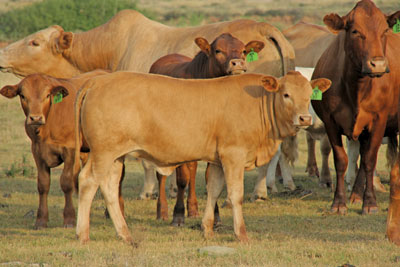
Alpha and Omega cows wean seven-month-old calves at an average of more than 45% of their body weight, making them exceptionally efficient beef producers. Photo courtesy of Alwyn Marx.
Groups of between
30 and 40 replacement heifers are run with self-bred, single sires. Heifers are mated in two groups at the ages of 14 to 15 months and 24 months. The average conception rate and the age of heifers first put to the bull illustrate the Tuli’s fertility, and the productive longevity of the cows confirms it. “I have 18-year-old and 19-year-old cows that are still producing,” says Alwyn. “The older cows are my most important cows, because they have proved themselves.”
The productive value of his older cows has played an important role in the rapid growth of the herd and justified their retention in the breeding herd, despite the arrival of the annual group of replacement heifers. Production costs per cow will drop as cows stay in the herd longer. Tuli cows calve easily in the veld and are outstanding mothers with good functional udders and high milk production, which ensures optimal calf growth.
Marketable weaners
With assured fertility, a cattleman can focus on selecting for the more heritable traits of conformation and associated meat production, explains Alwyn. “The Tuli’s fine bone structure allows for rapid muscling, fat deposition and excellent meat to bone ratio. These traits also allow the Tuli to maintain good condition especially after winter, enhancing the rate of successful conception.”
The Alpha and Omega Tuli cows currently wean calves at 7 months with average weights of 225kg for heifers and 235kg for bull calves off the veld with only a maintenance lick to help them through winter. “It’s impressive that these animals can consistently wean calves at above 45% of their own bodyweight,” says Alwyn. “Cows that calve every year and still wean good calves are rare.”
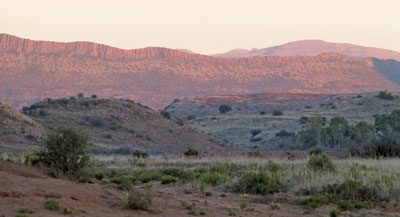
The rugged Stormberg mountains near Burgersdorp have an average annual rainfall of 450mm and are well known for extreme weather conditions. Alpha and Omega Tulis are run extensively in this environment with cows calving on the veld.
Alwyn feels that extensive beef farmers should be brutally honest about the demands set by the feedlot market in South Africa. “The medium- framed Tuli provides quality marketable weaners without eroding innate traits such as hardiness and fertility. Weaners below 180kg are simply not marketable to feedlots and would have to be grown out on the veld until the right weights were reached at about 12 months.
“The added grazing pressure must be understood in terms of the impact on overall farm production. Cow numbers often need to be reduced to accommodate these weaners. We should interpret the extra feeding required by larger-framed cows that produce heavier weaners in the same way.
“The Tuli offers a middle way between extremes of size, fertility and production, under extensive conditions,” he explains.
“A heavy milking cow will wean a big calf, but her intercalving period (ICP) is normally longer than that of other cows. The converse is also true: a smaller calf will come from a lighter milking cow with higher fertility. The optimal balance is obtained with a cow that can calve and wean 50% of her own weight every year.”
The Tuli seems to offer these advantages, meeting market requirements with minimal inputs. For ease of management, the breed scores high; polled, docile, a good mother, with longevity, resistant to tick-borne diseases and able to withstand high temperatures without signs of stress. "It’s hard to beat a beef breed that performs like this,” says Alwyn.
For more information visit www.alphaomegatulistud.co.za











